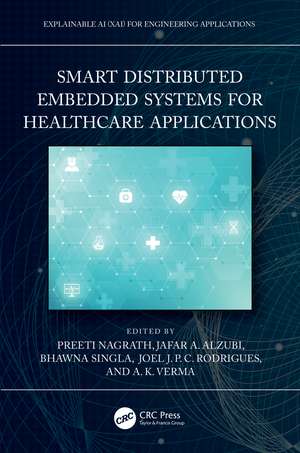Smart Distributed Embedded Systems for Healthcare Applications: Explainable AI (XAI) for Engineering Applications
Editat de Preeti Nagrath, Jafar A. Alzubi, Bhawna Singla, Joel J. P. C. Rodrigues, A. K Vermaen Limba Engleză Hardback – 21 apr 2023
| Toate formatele și edițiile | Preț | Express |
|---|---|---|
| Paperback (1) | 324.01 lei 3-5 săpt. | +16.38 lei 10-14 zile |
| CRC Press – 29 noi 2024 | 324.01 lei 3-5 săpt. | +16.38 lei 10-14 zile |
| Hardback (1) | 885.03 lei 6-8 săpt. | |
| CRC Press – 21 apr 2023 | 885.03 lei 6-8 săpt. |
Preț: 885.03 lei
Preț vechi: 1079.31 lei
-18% Nou
169.50€ • 174.63$ • 141.99£
Carte tipărită la comandă
Livrare economică 22 februarie-08 martie
Specificații
ISBN-10: 1032183470
Pagini: 198
Ilustrații: 17 Tables, black and white; 26 Line drawings, black and white; 35 Halftones, black and white; 48 Illustrations, color; 13 Illustrations, black and white
Dimensiuni: 156 x 234 x 13 mm
Greutate: 0.46 kg
Ediția:1
Editura: CRC Press
Colecția CRC Press
Seria Explainable AI (XAI) for Engineering Applications
Public țintă
Postgraduate and Undergraduate AdvancedCuprins
Chapter 1: Healthcare Engineering Using AI and Distributed Technologies
1.1 Introduction:
1.2 Related work
1.3 Impact of AI in the healthcare industry
1.4 Transforming healthcare with distributed computing
1.5 AI-based Robots in the healthcare ecosystem
1.6 Conclusion and Future Scope
Chapter 2: Cloud Computing in Healthcare: A Systematic Study
2.1. Introduction
2.2. Literature Review
2.3. MEDLINE
2.4 Monitoring Software for the Cloud
2.5 Biomedicine and healthcare benefit from cloud computing
2.6 Biotech Solutions in the Cloud
2.7. Cloud-based Molecular Simulation Tools
2.8 Cloud-based Medical Imaging Solutions
2.9. Medical Solutions in the Cloud
2.10. Fog computing and healthcare
2.11. Threats with cloud computing
2.12. Future Research
2.13 Conclusion
Chapter 3: Medical Information Extraction of Clinical Notes and Pictorial Visualization of Electronic Medical Records Summary Interface
3.1 INTRODUCTION
3.2 RELATED WORKS
3.3 PICTORIAL VISUALIZATION OF DATA
3.4 METHODOLOGY FOR INFORMATION EXTRACTION
3.5 RESULTS
3.6 CONCLUSION AND FUTURE WORK
Chapter 4: Investigations on RFID Enabled Healthcare Usage and Adoption Issues
4.1 Abstract
4.2 Background
4.3 RFID in Health Care System
4.4 RFID Adoption Issues
4.5 Conclusion
References
Chapter 5: Photonic crystal fiber plasmonic sensor for applications in medicine
5.1 Introduction
5.2 Background and development of photonic crystal fiber
5.3 Plasmonic sensor based on photonic crystal fiber
5.4 Fabrication Techniques
5.5 Future applications of plasmonic sensors
5.6 Conclusion
Chapter 6: (Augmented reality as a boon to disability)
6.1 Introduction: Aim and real use cases of augmented reality
6.2 Related work And Discussion
6.3 Technology Advancement Using AR for Empowering Disabled People
6.4 AR solutions for teaching specialized students
6.5 AR accessible technology to people
6.6 Conclusion
Chapter 7: (Augmented and Virtual Reality: Transforming the Future of Psychological and Medical Sciences)
7.1. Introduction
7.2 Use of AR Technology in Medical Science
7.3 Challenges and Opportunities
7.4 Conclusion
Chapter 8: Artificial Intelligence in Healthcare: Perspectives from Post-Pandemic times
8.2 Introduction
8.3 Applications of artificial intelligence (AI) in healthcare before Covid-19 pandemic
8.4 An Account of artificial intelligence (AI) guided aids in healthcare: Scenario from post pandemic times
8.5 Discussion
8.6 Conclusion
Chapter 9: Bioweapons v/s Computer Based Counter Measure Techniques and Mathematical modeling for prediction of Covid-19
9.1 Introduction and history
9.2 Genetically Engineered pathogens
9.3 Counter measure by computer based techniques
9.4 Mathematical model for COVID-19 Prediction
9.5 Conclusion
Chapter 10: Evolution of Healthcare Sector and Evolving Cyber Attacks ¿ A Summary
10.1 Healthcare industry and its revolution:
10.2 Role of Distributed System in Health Care
10.3 Why Healthcare is the biggest target for cyber attackers?
10.4 Cyber-attacks in healthcare industries - an infographic
10.5 Most frequent attacks in health industries and remedial measures
10.6 Research trends in cybersecurity for the health care sector
10.7 Conclusion ¿ Defending Healthcare sector from Cyberattacks
Chapter 11: Improving Cardiovascular Health by Deep learning
11.1 Introduction
11.2. Machine Learning
11.3 Next Generation Machine Learning
11.4 Applications of Artificial Intelligence for Cardiovascular Health
11.5 Future Scope
11.6 Challenges
11.7 Conclusion
Notă biografică
Dr. Preeti Nagrath is working as an Associate Professor in Bharati Vidyapeeth¿s College of Engineering. She has more than 19 years of Academic Experience. She is B.Tech (Computer Science and Engineering), M.Tech (Computer Science and Engineering) and PhD (Computer Science and Engineering). Her areas of research are Network security, Delay Tolerant networks, Machine learning and deep learning. She is the member of ISTE. She has more than 60 research papers in SCI- indexed journals, high reputed journals and international conferences. She is working on Government funded DST project on Women security. She has chaired many sessions in international conferences. She is appointed as a reviewer in many conferences and journals. She has organized many faculty development programs, workshops, hackathons and Guest lectures. She has mentored teams in Smart India Hackathons. She is Associate Editor of Journal of Multi-Disciplinary Engineering Technologies, Bharati Vidyapeeth¿s College of Engineering, New Delhi.
Jafar A. Alzubi is an Associate Professor at Al-Balqa Applied University, School of Engineering, Jordan. Received Ph.D. degree in Advanced Telecommunications from Swansea University, Swansea ¿ UK (2012). Master of Science degree (Hons.) in electrical and computer engineering from New York Institute of Technology, New York - USA (2005). And Bachelor of Science degree (Hons.) in Electrical Engineering, majoring in Electronics and Communications, from the University of Engineering and Technology, Lahore ¿ Pakistan (2001). Jafar works and researches in multi and interdisciplinary environment involving Machine Learning, classifications and detection of Web scams, Internet of Things, Wireless Sensor Networks, Cryptography, and using Algebraic¿Geometric theory in channel coding for wireless networks. He managed and directed few projects funded by the European Union. A cumulative research experience for over ten years, resulted in publishing more than Sixty papers in highly impacted journals. Currently, he is senior IEEE member and serving as an editor for IEEE Access Journal, and Wireless Sensor Networks area editor for Turkish Journal of Electrical Engineering and Computer Sciences. In addition, he is editorial board member and reviewer in many other prestigious journals in computer engineering and science field. He is also managing several special issues in high impacted journals.
Dr. Bhawna Singla has received her doctorate degree from Thapar University, Patiala, India. She is currently working as Professor of Computer Science and Engineering Department, PIET College of Engineering and Technology, Samalkha, Panipat, India. She organized and participated in several national level seminars and conferences. She has more than 15 years of rich academic experience. She has published more than 25 research papers in International Journals/Conferences and edited Books. She is in editorial and in the review panel of many International Journals. She organized a National Level Seminar on "Mobile Computing and Mobile Applications Development (MOBAPP-2014) which is dedicated to state of the art research on mobile computing and its application including services. She participated in the organizing activities of an International Conference on Emerging Technologies - ICET-2014, Futuristic Technologies (ICFT 2019).
Joel J. P. C. Rodrigues [S¿01, M¿06, SM¿06, F¿20] is a professor at College of Computer Science and Technology, China University of Petroleum (East China), senior researcher at the Instituto de Telecomunicações, Portugal; and collaborator of the Post-Graduation Program on Teleinformatics Engineering at the Federal University of Ceará (UFC), Brazil. He also worked at the Federal University of Piauí, Brazil. Prof. Rodrigues is the leader of the Next Generation Networks and Applications (NetGNA) research group (CNPq), an IEEE Distinguished Lecturer, Member Representative of the IEEE Communications Society on the IEEE Biometrics Council, and the President of the scientific council at ParkUrbis ¿ Covilhã Science and Technology Park. He was Director for Conference Development - IEEE ComSoc Board of Governors, Technical Activities Committee Chair of the IEEE ComSoc Latin America Region Board, a Past-Chair of the IEEE ComSoc Technical Committee on eHealth, a Past-chair of the IEEE ComSoc Technical Committee on Communications Software, a Steering Committee member of the IEEE Life Sciences Technical Community and Publications co-Chair. He is the editor-in-chief of the International Journal of E-Health and Medical Communications and editorial board member of several high-reputed journals. He has been general chair and TPC Chair of many international conferences, including IEEE ICC, IEEE GLOBECOM, IEEE HEALTHCOM, and IEEE LatinCom. He has authored or coauthored over 950 papers in refereed international journals and conferences, 3 books, 2 patents, and 1 ITU-T Recommendation. He had been awarded several Outstanding Leadership and Outstanding Service Awards by IEEE Communications Society and several best papers awards. Prof. Rodrigues is a member of the Internet Society, a senior member ACM, and Fellow of IEEE.
Dr. A K Verma is currently working as Professor in the department of Computer Science and Engineering at Thapar Institute of Engineering & Technology, Patiala in Punjab (INDIA). He received his B.E., M.E. and PhD. in 1991, 2001 and 2008 respectively, majoring in Computer Science and Engineering. He has worked as Lecturer at M.M.M. Engg. College, Gorakhpur (now, M.M.M. University of Technology) from 1991 to 1996. Onwards 1996 he is associated with Thapar Institute of Engineering & Technology. He is leading the research group on Mobile Computing and Communication (MC2) at Thapar Institute of Engineering & Technology. He has published over 150 papers in refereed journals and conferences (India and Abroad). He is member of various program committees for different International/National Conferences and is on the review board of various International/National journals. He has visited ¿ USA (2005), South Korea(2012), Japan(2013), Ireland(2015) and Bahrain(2017) for academic purpose. He is a MACM (USA), MISCI (Turkey), LMCSI (Mumbai), GMAIMA (New Delhi). He is a certified software quality auditor by MoCIT, Govt. of India.
Descriere
This book discusses the applications and optimization of emerging smart technologies in the field of healthcare.
It further explains different modeling scenarios of the latest technologies in the healthcare system and compares the results to better understand the nature and progress of diseases in the human body, which would ultimately lead to early diagnosis and better treatment and cure of diseases with the help of distributed technology.
- Covers the implementation models using technologies such as artificial intelligence, machine learning, and deep learning with distributed systems for better diagnosis and treatment of diseases.
- Gives in-depth review of technological advancements like advanced sensing technologies such as plasmonic sensors, usage of RFIDs, and electronic diagnostic tools in the field of healthcare engineering.
- Discusses possibilities of augmented reality and virtual reality interventions for providing unique solutions in medical science, clinical research, psychology, and neurological disorders.
- Highlights the future challenges and risks involved in the application of smart technologies such as cloud computing, fog computing, IOT, and distributed computing in healthcare.
- Confers to utilize the AI and ML and associated aids in healthcare sectors in the post-Covid 19 period to revitalize the medical setup.
Contributions included in the book will motivate technological developers and researchers to develop new algorithms and protocols in the healthcare field. It will serve as a vast platform for gaining knowledge regarding healthcare delivery, health- care management, healthcare in governance, and health monitoring approaches using distributed environments. It will serve as an ideal reference text for graduate students and researchers in diverse engineering fields including electrical, electronics and communication, computer, and biomedical fields.




















